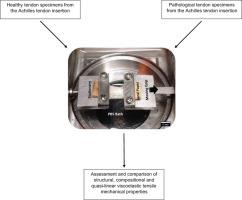Journal of the Mechanical Behavior of Biomedical Materials ( IF 3.3 ) Pub Date : 2020-08-19 , DOI: 10.1016/j.jmbbm.2020.104031 Ibrahima Bah 1 , Ninoshka R J Fernandes 1 , Ruth L Chimenti 2 , John Ketz 3 , A Samuel Flemister 3 , Mark R Buckley 1

|
Insertional Achilles tendinopathy (IAT) is a painful condition that is challenging to treat non-operatively. Although previous studies have characterized the gross histological features, in vivo strain patterns and transverse compressive mechanical properties of tissue affected by IAT, it is not known how IAT impacts the tensile mechanical properties of the Achilles tendon insertion along the axial/longitudinal direction (i.e., along the predominant direction of loading). To address this knowledge gap, the objectives of this study were to 1) apply ex vivo mechanical testing, nonlinear elastic analysis and quasilinear viscoelastic (QLV) analysis to compare the axial tensile mechanical properties of the Achilles tendon insertion in individuals with and without IAT; and 2) use biochemical analysis and second harmonic generation (SHG) imaging to assess structural and compositional changes induced by IAT in order to help explain IAT-associated tensile mechanical changes. Tissue from the Achilles tendon insertion was acquired from healthy donors and from patients undergoing debridement surgery for IAT. Tissue specimens were mechanically tested using a uniaxial tensile (stress relaxation) test applied in the axial direction. A subset of the donor specimens was used for SHG imaging and biochemical analysis. Linear and non-linear elastic analyses of the stress relaxation tests showed no significant tensile mechanical changes in IAT specimens compared to healthy controls. However, SHG analysis showed that fibrillar collagen was significantly more disorganized in IAT tissue as compared with healthy controls, and biochemical analysis showed that sulfated glycosaminoglycan (sGAG) content and water content were higher in IAT specimens. Collectively, these findings suggest that conservative interventions for IAT should target restoration of ultrastructural organization, reduced GAG content, and reduced resistance to transverse compressive strain.
中文翻译:

由于插入性跟腱病引起的跟腱拉伸机械变化。
插入性跟腱病 (IAT) 是一种痛苦的疾病,非手术治疗具有挑战性。尽管先前的研究已经表征了受 IAT 影响的组织的大体组织学特征、体内应变模式和横向压缩力学性能,但尚不清楚 IAT 如何影响沿轴向/纵向方向的跟腱插入的拉伸力学性能(即,沿主要加载方向)。为了解决这一知识差距,本研究的目标是 1) 应用体外机械测试、非线性弹性分析和准线性粘弹性 (QLV) 分析,以比较有和没有 IAT 的个体跟腱插入的轴向拉伸机械性能;2) 使用生化分析和二次谐波生成 (SHG) 成像来评估 IAT 引起的结构和成分变化,以帮助解释 IAT 相关的拉伸机械变化。跟腱止点的组织是从健康捐赠者和接受 IAT 清创手术的患者那里获得的。使用沿轴向施加的单轴拉伸(应力松弛)测试对组织样本进行机械测试。一部分供体标本用于 SHG 成像和生化分析。应力松弛试验的线性和非线性弹性分析表明,与健康对照相比,IAT 试样中没有显着的拉伸机械变化。然而,SHG 分析表明,与健康对照相比,IAT 组织中的纤维状胶原蛋白明显更杂乱,生化分析表明,IAT 标本中硫酸化糖胺聚糖 (sGAG) 含量和水含量更高。总的来说,这些发现表明 IAT 的保守干预应该针对超微结构组织的恢复、减少 GAG 含量和降低对横向压缩应变的抵抗力。生化分析表明,IAT标本中硫酸化糖胺聚糖(sGAG)含量和水分含量较高。总的来说,这些发现表明 IAT 的保守干预应该针对超微结构组织的恢复、减少 GAG 含量和降低对横向压缩应变的抵抗力。生化分析表明,IAT标本中硫酸化糖胺聚糖(sGAG)含量和水分含量较高。总的来说,这些发现表明 IAT 的保守干预应该针对超微结构组织的恢复、减少 GAG 含量和降低对横向压缩应变的抵抗力。











































 京公网安备 11010802027423号
京公网安备 11010802027423号